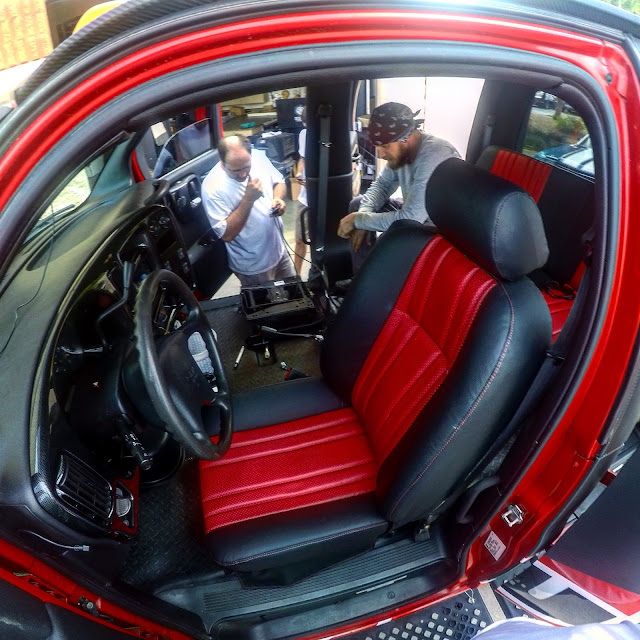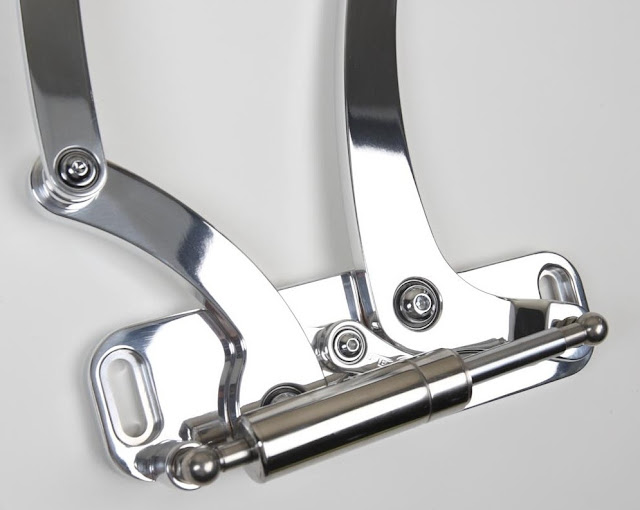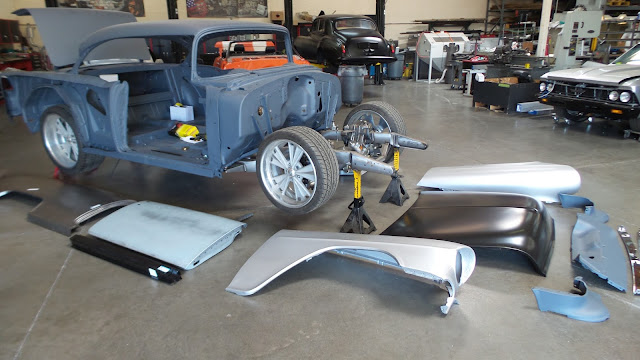Thursday, July 30, 2015
July 30th Photo Blog Post
So busy this week we went with a true "Photo Blog" post. Which is to say, "just photos." Here's what we've been up to!
Monday, July 27, 2015
A brief history of Fesler Built
Ever since the birth of the muscle car (1949 if you hold to
the legacy of the Oldsmobile Rocket 88) people who love powerful automobiles
have been turning out new creations and striving for great heights of
perfection where it comes to putting four wheels on the road with the most
oomph possible behind them.
Chris and Carrie Fesler are no exception to the rule. Driven
by a love of custom cars, they began in the late 1990s, shooting and writing
magazine articles as promotional pieces for manufacturers in the automotive
industry. Eventually, they began to design these vehicles, working closely with
companies to build, show and advertise custom cars and trucks designed to
showcase a particular company’s products.
Carrie Fesler remarks that many believe the two inherited
their business. Nothing could be further from the truth. What the Fesler’s did
inherit was a lot of good advice and mentorship from the industry contacts they
made along the way. The road from shooting magazine articles to turning out
1969 Camaros that command six-figure prices was a long one.
In 1996, the Feslers began producing complete editorial
packages for magazines. Chris’ stunning photography and Carrie’s writing skills
complimented each other, making for mouthwatering pieces about the vehicles
featured therein. Other marketing services offered to help manufacturers reach
out to publications grew to include actually designing and building the cars
for the articles.
By 2000, the Fesler name had become a staple in the
industry, with several projects produced for SEMA, the industry’s premier trade
show, each year. Fesler built show cars for General Motors, Jeep, Kenwood, and
Kicker, to name a few. However, building cars would quickly become Chris and
Carrie’s passion.
In the mid-2000s, Fesler Built shifted from building demo
cars for companies to building custom cars for individuals. Now, Fesler Built builds turn-key muscle
machines, the stuff octane-scented dreams are made of.
In 2009, after the recession took its toll on the economy,
the Chris and Carrie realized that their next response to the market would be
in parts. Fesler Billet was launched to provide a quality line of products to
DIY enthusiasts who were looking to build their own cars, rather than pay to
have them built. Fesler Billet parts have achieved notoriety for their quality
and design imagination.
Finally, in 2014, Fesler Detail was launched, a
collaboration with a friend in the car detailing business to produce superior
auto detailing products. Other offerings on the market weren’t giving Fesler
Built cars the shine they used to, largely due to shipping production overseas,
and Chris and Carrie saw the opportunity to fill a need in the market by
producing superior detail products.
So, when they aren’t building a sweet Camaro, designing a
new part to go on that Camaro, perfecting the wax to make that Camaro shine, or
taking great pictures of it, the Feslers are constantly looking for new ways to
serve the automotive industry.
And now you know the history of Fesler Built.
And now you know the history of Fesler Built.
Thursday, July 23, 2015
July 23rd Photo Blog
It’s been an interesting week at Fesler. We’ve seen huge
progress on the 1955 Bel Air, moved forward on other projects and got a 1969
C-10 in the shop for new interior and a few other upgrades.
Let’s start with the Bel Air. This week was focused on
getting the rear end ready for rear quarter panels and rear bumper – work that
will most likely continue on into next week. Rust repair had been done and new
pieces are going in to replace what had to be cut out.
Next up, the wheel well.
The 1969 Camaro got a new trunk floor and sub frame modifications.
Now it’s waiting on the new rear suspension.
And here’s a few gratuitous Camaro pics because, why not?
Last, but not least, is the 1969 C-10 that came in for a
fresh interior and A/C from Vintage Air.
So, that’s been the week at Fesler Built! One more thing,
though…check it out in next week’s blog!
Monday, July 20, 2015
Making new Fesler Billet parts
What goes in to making a new billet
aluminum part at Fesler Billet? How is the decision made to produce some parts
for some cars over other parts for other cars? Let’s take a look at the
decision-making process.
Fesler Built has been designing
custom parts for the cars it builds for a several years now. Investing in the
tools and personnel to make those parts available to the public has been a
viable outlet for the company. When the economy tanked in 2008 people weren’t looking
to build as many six-figure custom cars but they were looking for a good deal
on great parts for the cars they had already.
So, Fesler Billet was created to
focus on making more parts for more cars. Judging how many cars of a particular
model and year are still on the road, which ones are popular with DIY modifiers
and restorers, as well as which parts those individuals are interested in,
allowed Fesler to shrewdly produce parts that would fly off the shelves and
look great on show cars and personal vehicles alike around the country and the
world.
Whereas Fesler used to take a car
that happened to come into the shop and try to design many different parts for
it, it has become just as useful to ask for suggestions from the public.
Clients suggest a part and are asked to send one in for examination. In return,
if the part it produced, they will receive a free production part when it is
complete.
However, what the public should
understand is that the next part of the process can take a great deal of time,
even years. Researching the market for a potential product, producing a unique
design for the Fesler Billet brand, prototyping and testing samples and then
mass testing with a network of people who own the vehicle in question can all
take a very long time. The development process alone can take weeks. Fesler
employs an engineer full-time to develop and improve part designs.
And that’s not even touching the cost. Developing a part can run into the tens of thousands of dollars and, at the end, there’s only a gamble (well researched, albeit) that the part will sell well. Then, when a new part is produced, it only raises the chances that competitors will design their own part or even reintroduce a previously retired design for the part.
And that’s not even touching the cost. Developing a part can run into the tens of thousands of dollars and, at the end, there’s only a gamble (well researched, albeit) that the part will sell well. Then, when a new part is produced, it only raises the chances that competitors will design their own part or even reintroduce a previously retired design for the part.
That’s why Carrie Fesler says every
time she sees a new hood hinge that looks suspiciously like a Fesler hinge, she
laughs. With as many as 36, small, time-consuming parts to make for some
applications, hood hinges demand a higher investment, in daily production as
well as initial development, relative to other, single-piece parts. Those who
want to make a quick buck on their own hinges, she says, are more than welcome
to try.
So, next time you see a new Fesler
part in the store or in posts from SEMA, keep in mind how much effort goes into
bringing that part to market.
Thursday, July 16, 2015
July 16th Photo Blog
Fesler has certainly been busy this week. The shop is
buzzing and vehicles are moving from station to station all the time.
The 1955 Bel Air has come down off of the lift it had
been resting peacefully atop and the new body panels are going on.
Next week should see large changes to this vehicle.
The 1975 911 is getting more fine-tuning on the body. Small
amounts of body correction here and there ensure the vehicle will look its very
best when painted.
The inside is starting to come together as well.
 The interior panels and seats for the GMC TopKick
are nearly finished.
The interior panels and seats for the GMC TopKick
are nearly finished.

The seats have a really excellent new look, too!

The panels are starting to go back in. This rig will have a
whole new, impressive feel to it!
The Fesler 1969 Camaro is getting some big suspension
adjustments, swapping the bags for coils.
Also, the trunk is being closed up to improve its usefulness
as a storage space.
That's just the big, photogenic stuff! Watch Fesler social media for more updates and be sure to check out Monday's blog post, which might be about how Fesler decides what kind of billet parts to design and sell!
Have a great weekend!
That's just the big, photogenic stuff! Watch Fesler social media for more updates and be sure to check out Monday's blog post, which might be about how Fesler decides what kind of billet parts to design and sell!
Have a great weekend!
Monday, July 13, 2015
“Where are my Fesler Billet Parts?”
We’ve all been there. You order something from a website and
then start watching the door for it to arrive. A few days go by, you start
checking your e-mail more often. A few weeks go by, you start to wonder, “Where
is my product?” After a few months, the wait can seem unbearable. Finally, you
call and ask; “Where the heck is my order?” Sometimes the answer suffices -
other times not so much.
But what causes the delay in Fesler customers receiving parts ordered from Fesler Built? Hopefully, this post will enlighten those waiting and wondering.
Fesler Built and its parts division, Fesler Billet, offer
hundreds of parts for sale covering a variety of vehicles and desired looks for
those vehicles. Ideally, the parts are all sitting in storage, waiting to
drop-ship. When orders come in for parts that are sitting on the shelves,
there’s rarely ever an issue.
However, when orders come in for parts that are
sold-out, problems arise. Often, a part will go from in-stock to sold-out very
quickly, as orders seem to come in quickly and in groups.
 |
| Fesler trunk hinges in production |
Part orders come in from customers constantly and are
processed by the type of part ordered. Once a certain amount of an out-of-stock
part has been ordered, an in-house work order goes out to begin production. The
challenge is in determining what to make first. Normally, production is based
on order date but, when some products sell more units than others, the plan
must be adjusted to ensure the back-order list doesn’t grow too large. Ideally,
parts that take longer to make are made before parts with faster turnaround
times to ensure customers are served in the same time-frame.
There’s also the small monkey wrench of prototyping. Fesler
is constantly looking for new product ideas to bring to market. These ideas
must be tested first and that testing ties up the machines which would
otherwise be producing parts for shipping. The demand for existing Fesler
Billet parts has grown to such a magnitude that production demands have allowed
almost no time for prototyping at all. While that’s a nice challenge for Fesler
to be faced with, it’s a difficult one, just the same.
Another aspect of the challenge is production times for
individual parts, which can vary widely. For example, a 1968 Camaro tail light,
which doesn’t see many orders, takes two-and-a-half hours to complete, per set.
A 1969 Camaro tail light, almost constantly teetering between “in-stock” and “back-ordered,”
takes 30 minutes per set. So, when a whole stack of orders for ’69 tail lights
comes in right after the last set on hand is sold - and along comes a few
orders for ’68 tail lights before that part has gotten its turn in regular
production, the question of which part to start work on first is a real
conundrum.
 |
| Fesler Billet 1969 Camaro "Fesler Sport" 3D Tail Lights |
In the end, Fesler Billet products, although produced in the
U.S.A. and held to the same standard of quality that Fesler Built cars and SEMA
productions are renowned for, are experiencing growing pains. Rest assured that
Fesler Billet is working hard to ensure customers receive parts they order as
quickly as possible.
Thursday, July 9, 2015
July 9th Photo Blog Post
It's been an exciting week at Fesler, a couple of projects got off to a
running start while a few are nearing completion. Here's the week at Fesler, in
pictures!
Project Blaze has been in the process of getting a totally new look for some time now. The new owner wanted the lifted look and Fesler has delivered in spades. Now, for reasons we can't disclose, Fesler Built may have promised a certain magazine not to post any more professional shots of the truck until they get a chance to do so in print, but that doesn't mean we can't show you shop pics of what's happened!

As you can see above, the grill was bolstered with metal mesh to defend the radiator, hand-made in
the shop, of course.
The wheel-wells came out nicely, after paint, with a tougher version of the same color ready to deal with rocks tossed up by those sweet, sweet 37-inch Nittos.
Finally, a set of Tyger rock guards now hug the rocker panels to protect that beautiful paint and provide a step up into this now very much lifted Blazer.
The 1966 Chevelle that has been waiting patiently saw some very fast progress this week. Things are really ramping up with this build.
Ron Francis Wiring will make sure all the creature comforts, including that supercharged LS3, operate smoothly.
The dash went in, complete with Autometer gauges, as well as the steering column and wheel.
This beast came in on Wednesday for an all-new, custom interior. Look to see some very pretty stitching inside soon.
Project Blaze has been in the process of getting a totally new look for some time now. The new owner wanted the lifted look and Fesler has delivered in spades. Now, for reasons we can't disclose, Fesler Built may have promised a certain magazine not to post any more professional shots of the truck until they get a chance to do so in print, but that doesn't mean we can't show you shop pics of what's happened!

As you can see above, the grill was bolstered with metal mesh to defend the radiator, hand-made in
the shop, of course.
The wheel-wells came out nicely, after paint, with a tougher version of the same color ready to deal with rocks tossed up by those sweet, sweet 37-inch Nittos.
Finally, a set of Tyger rock guards now hug the rocker panels to protect that beautiful paint and provide a step up into this now very much lifted Blazer.
The 1966 Chevelle that has been waiting patiently saw some very fast progress this week. Things are really ramping up with this build.
Ron Francis Wiring will make sure all the creature comforts, including that supercharged LS3, operate smoothly.
The dash went in, complete with Autometer gauges, as well as the steering column and wheel.
This beast came in on Wednesday for an all-new, custom interior. Look to see some very pretty stitching inside soon.
So, that’s what we’ve been up to this week at Fesler Built.
We hope you enjoy the photos and keep watching our social media to keep up with
these projects as they move forward to completion.
Don’t forget to check out the Fesler Fan group on Facebook.
Join other #feslerfans sharing photos of their cars and discussing related
topics! Anyone can join!
https://www.facebook.com/groups/feslerfans/
*Note: Projects spotlighted are chosen by the blog writer, other projects are in progress as well.
*Note: Projects spotlighted are chosen by the blog writer, other projects are in progress as well.
Subscribe to:
Posts (Atom)


















































